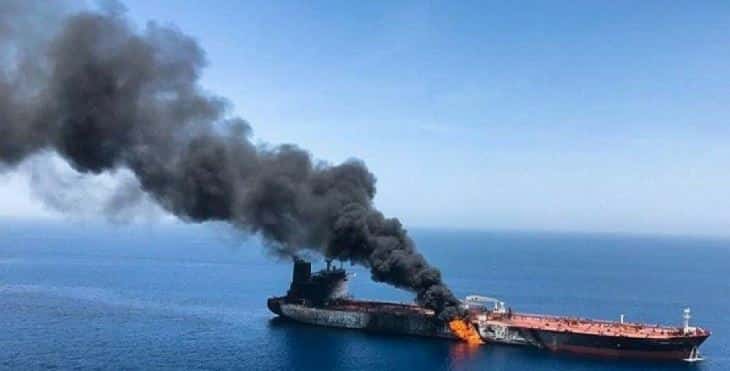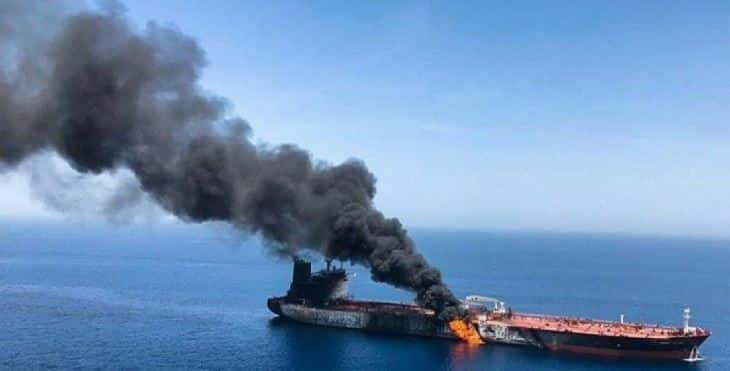Wednesday afternoon’s attack on the Pacific Zircon, a tanker in the Gulf of Oman, owned by Israeli billionaire Idan Ofer, comes amidst a time of increased tensions in the region, with both Israel and the United States immediately placing the blame on Iran.
For the past two months, the Islamic Republic has been rocked by riots, ostensibly in response to the death of Mahsa Amini, a 22-year old Iranian woman who passed away suddenly following an interaction with a female police officer in Tehran. The involvement of regime-change agent Masih Alinejad, and the recent admission by former US National Security Advisor John Bolton that weapons are being supplied to the “Iranian opposition” however, acts as effective confirmation that what had initially begun as legitimate protests, have now been hijacked by Western Intelligence agencies in a bid to implement regime change in Iran, with a similar strategy having previously been carried out in Libya and Syria.
With the eyes of the world focused on the current unrest in Iran, and with the Islamic Republic due to play their inaugural game in the 2022 Qatar World Cup against England on Monday, the question must be asked as to what would be the strategic importance for Tehran to launch a Drone attack on an Israeli-owned tanker at this time, a move with a realistic likelihood of drawing a Western military response?
Indeed, a similar scenario played out in June 2019, when on the same day that then-Prime Minister of Japan Shinzo Abe held a meeting with Ayatollah Khameini in Tehran, with the intention of diffusing tensions between Iran and the United States, mine attacks would be launched against Japanese and Norwegian-owned tankers in the Gulf of Oman.
Again, the blame was immediately placed on Iran for the attacks by the United States, Britain and Saudi Arabia, despite their being no apparent strategic importance for Tehran to carry them out.
In fact, Iran had no issue claiming responsibility for the shooting down of a US Military Drone that had flew over the coastal province of Hormozgan a week later, an objectively more provocative act than attacking two tankers, and one which nearly did draw a US military response, with then-President Donald Trump stating in an interview that he had called off the planned attack ten minutes before it was due to begin, preventing the start of an immediate and devastating regional conflict.
Like the similarity between what is currently playing out in Iran and the Syrian regime change operation, in which arms, funding and training were also provided to so-called ‘opposition’ groups, false flag attacks intended to draw a Western military response also took place against Damascus.
In 2017, Syria had been in the grip of a six-year long proxy war, launched in response to Bashar al-Assad’s 2009 refusal to allow US-ally Qatar to build a pipeline through his country.
Following a requested Iranian military intervention in June 2013, and a further Russian air campaign that began in September 2015, Damascus had made great strides in regaining the vast swathes of its territory that had come under the control of Western-backed terrorist groups since the regime change operation had begun in March 2011.
In order to counter this, Washington’s regime change lobby would ultimately resort to reckless measures.
On the 4th of April 2017, a false flag chemical attack would take place in the Syrian town of Khan Shaykhun, located in the terrorist-controlled Idlib province. With the blame immediately being placed on Damascus, the then-US Trump administration would launch 59 cruise missiles against the Syrian government-controlled Shayrat Airbase three days later, the first direct engagement between US and Syrian forces, though one that just stopped short of the Libya-style intervention that Washington’s Neocons had clamoured for.
Undeterred however, another false flag chemical attack would take place almost a year to the day later, this time in the city of Douma, which would also result in the US, Britain and France launching air strikes against Syrian government targets.
Again however, this would ultimately not escalate into a full-scale military intervention, and this course of action will hopefully not be repeated against Iran amidst the current disturbances, as Tehran’s military capabilities – noticeably displayed in the January 2020 retaliatory missile strike on the Ain Al-Assad US airbase in neighbouring Iraq – would ensure that even a “limited” Syria-style strike against Iranian military infrastructure would immediately result in the eruption of a widespread regional conflict.
A conflict, that with the high possibility that Iran’s Russian and Chinese allies may decide to become involved, would have the potential to reach far beyond the Persian Gulf.


